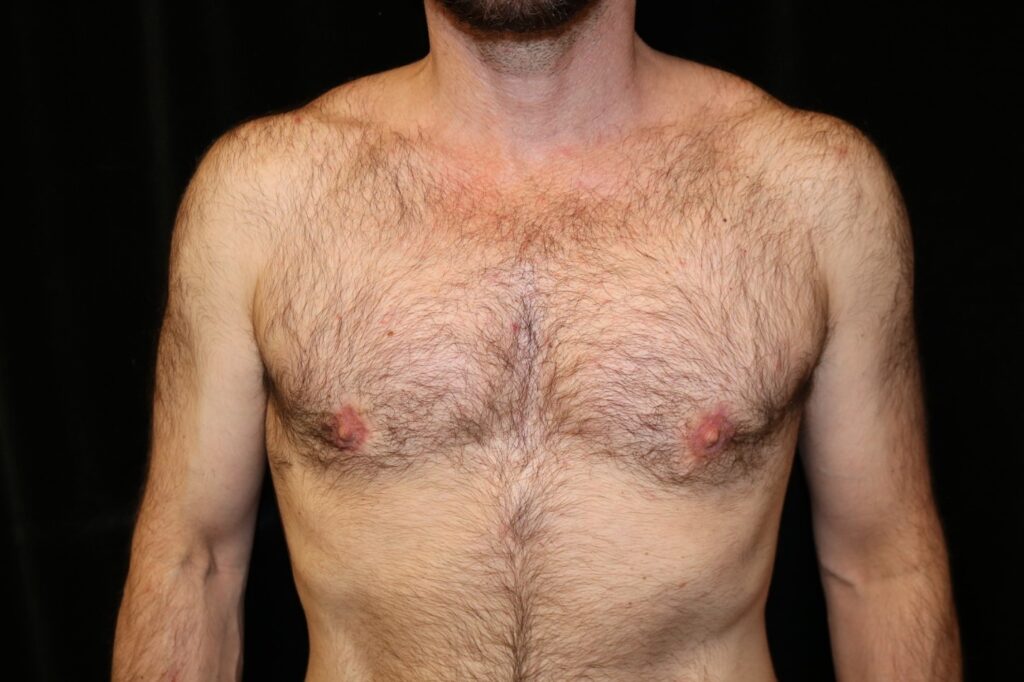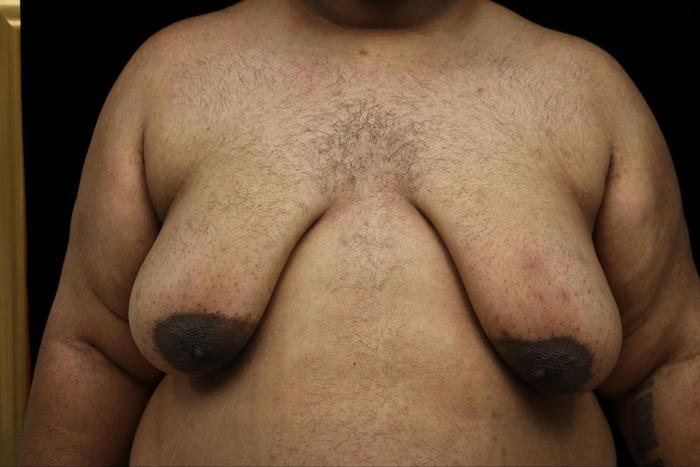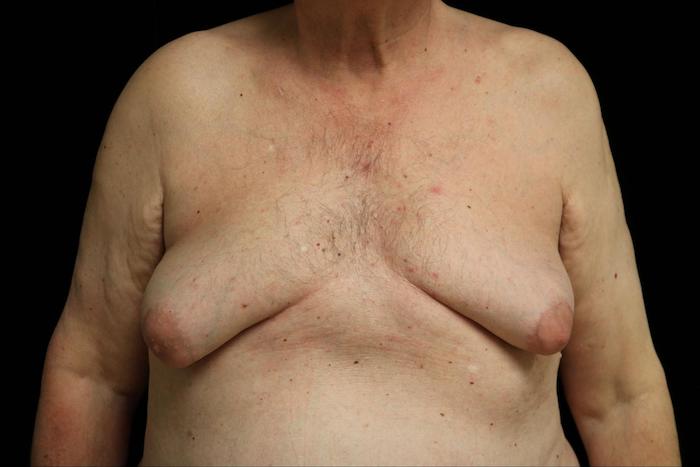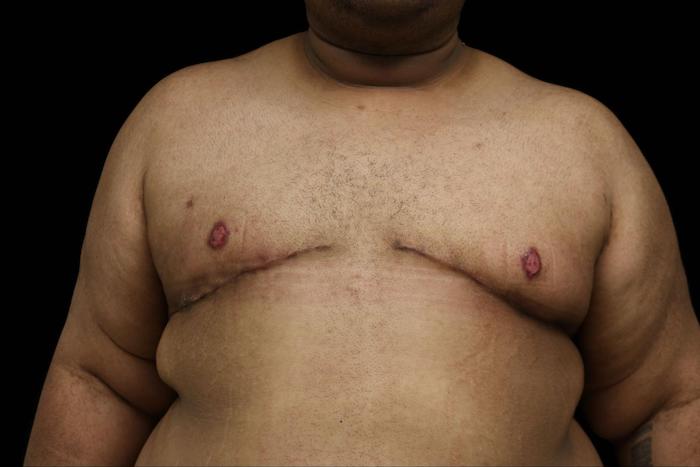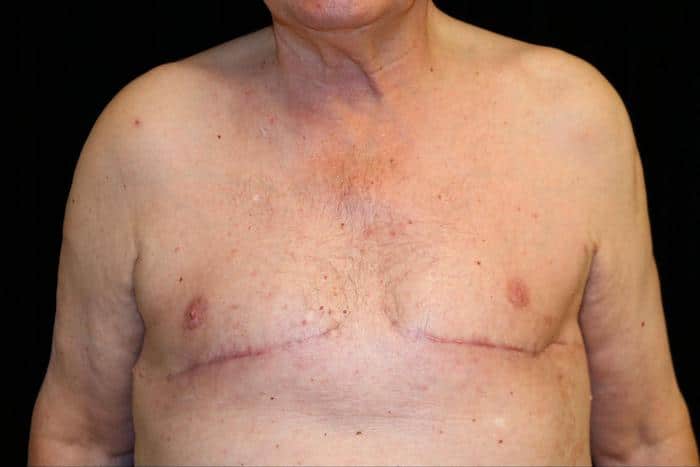Contact Us
 Dr. Delgado is a highly skilled surgeon specializing in gynecomastia surgery. Dr. Delgado has committed a significant amount of his practice to the care and education of men and boys with gynecomastia. Dr. Delgado’s practice philosophy is to provide the highest quality of patient care to the people who seek out his professional services. Dr. Delgado and his staff are committed to understanding their patients' concerns, educating them on their options, and executing the best surgical outcome for each patient. Dr. Delgado is the new owner of Gynecomastia.org since 2010. He has dedicated a significant part of his life and practice to improving the Gynecomastia.org community.
Dr. Delgado is a highly skilled surgeon specializing in gynecomastia surgery. Dr. Delgado has committed a significant amount of his practice to the care and education of men and boys with gynecomastia. Dr. Delgado’s practice philosophy is to provide the highest quality of patient care to the people who seek out his professional services. Dr. Delgado and his staff are committed to understanding their patients' concerns, educating them on their options, and executing the best surgical outcome for each patient. Dr. Delgado is the new owner of Gynecomastia.org since 2010. He has dedicated a significant part of his life and practice to improving the Gynecomastia.org community.
Minimally Invasive Gynecomastia Surgery — Breast Gland Excision with Liposuction
Gynecomastia surgery involves the removal of enlarged male breast glands, which is often combined with liposuction of the chest. This surgical approach removes the glandular tissue and contours the chest area into a masculine-looking, sculpted chest. The minimal incision technique successfully treats 80% of men with enlarged male breasts.
The best patients for this male breast reduction procedure are those with youthful, elastic skin that will contract following the removal of excess fatty tissue, glands, and skin. The process of skin contraction is similar to how a rubber band works. The newer the rubber band, the better the snap-back. The older the rubber band, the more relaxed it becomes.
The aging process naturally breaks down the collagen and elastin fibers that give skin elasticity and the ability to contract. In general, younger patients will experience satisfactory skin contraction, while older patients may require more extensive procedures to facilitate skin removal. Dr. Delgado has extensive experience to determine your “snap back test” to ensure the success of your surgery.
Various factors can impair skin quality and, as a result, the outcome of your surgery, include:
- Photoaging or sun damage
- Massive weight loss
- Genetics and ethnicity
- Stretch marks
“John’s Story “ — Follow Miguel Delgado, M.D., into the operating room to see how he performs the standard male breast reduction surgery — breast gland excision with liposuction.
Standard Male Breast Reduction Technique
The standard gynecomastia treatment technique is suitable for most individuals with grade 1 or 2 gynecomastia symptoms. In some cases of grade 3 symptoms, the standard technique can also produce successful results.
The majority of surgery for male breast reduction is performed under light general anesthesia. However, some surgeons will perform the procedure under local anesthesia, with or without IV sedation. Dr. Delgado prefers light general anesthesia, as it gives total control during surgery and keeps the patient comfortable to avoid excess bleeding and provide the highest possible optimal results.
In most cases, liposuction is performed through a small incision in the armpit, breast fold, or areola to access the excess fat and sculpt the chest. Once the liposuction is complete, the glandular and fat tissue is carefully removed until a masculine contour is achieved.
Drainage tubes are then placed on each side, and the incision is sutured closed. Once the surgery is complete, foam and a specialized compression garment are placed around the chest. This specialized garment, designed by Dr. Delgado, is a customized vest shaped to the male physique to optimize compression and control bleeding.
Pull-Through Technique
The “pull-through” gynecomastia surgery technique is a minimally invasive procedure, usually recommended for men with Grade 1 and, on occasion, Grade 2 gynecomastia symptoms. This technique uses an even smaller incision than the standard minimally invasive gynecomastia technique.
The “pull-through technique” requires just a tiny 5 mm incision made at the lower edge of the areola. Liposuction contours the fat and blends in the shape surrounding the area. The nipple area is separated from the underlying breast tissue. A unique instrument is used to pull the breast tissue out of the incision. Additional sculpting with liposuction and scissor dissection completes this surgery. The closure and post-op dressing is the same as the standard procedure.
Gynecomastia Surgery Treatment with Excess Skin
Generally, men with Grade 3 or Grade 4 gynecomastia symptoms have a significant amount of excess skin. This is challenging to treat because of limits to the degree of natural skin contraction.
If loose skin is left following liposuction and surgical removal of the glandular tissue, then surgical removal of the skin is necessary. Longer incisions are needed. However, every effort will be made to keep incisions to a minimum.
Two-stage Procedure for Removing Excess Skin
The two-stage procedure is an advanced cosmetic surgery procedure for men with mild to moderate skin laxity. First, the standard male breast reduction procedure is performed. The second stage is a periareolar lift performed under a local anesthetic between four and six months after the initial procedure. This allows the blood supply to re-establish with the nipple-areola complex.
During the second stage, skin reduction begins with an incision around the entire areola, followed by a second larger circle incision. The skin and tissue between these incisions form a donut shape that is removed. The gap is then meticulously closed with a permanent suture and the patient is fitted with a compression garment.
One-minute video of periareolar lift.
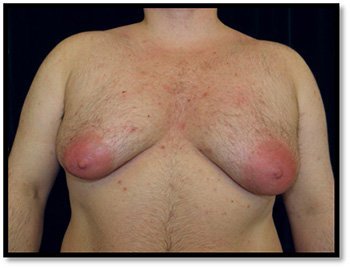
Pre-op reads Adolescent hypogonadism
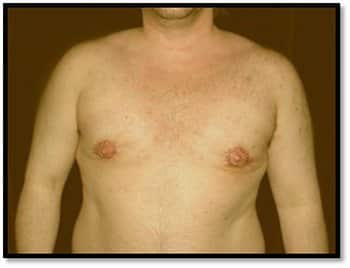
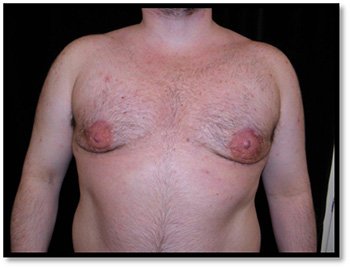
Four years after surgery with hormone therapy and a healthy lifestyle
Double Incision Mastectomy for Severe Gynecomastia
Double incision mastectomy includes a free nipple graft and is suitable for some grade 3 and all grade 4 gynecomastia patients. Patients might have a breast size of C, D, or higher. Men with excess skin are typically overweight or have lost a significant amount of weight. The incision is located in the breast fold and extends toward the armpit. The incision length depends on how far the redundant tissue extends toward the back.
An infusion solution is injected once the patient is fully under general anesthetic, then the nipple-areola complex is completely removed and resized to about the size of a nickel. Incisions are made, and glandular and fatty tissue is removed in the sitting position to take into account the effect of gravity on the tissue before removal. This allows an accurate assessment to ensure the proper amount of glandular tissue and skin is removed for a tight and contoured chest.
The nipple-areola complex is then reattached to create a masculine-looking chest that looks aesthetically correct. A compression vest is placed around the chest, which completes the operation.
The advantage of this technique is that removing excess skin provides the patient with a tightly contoured chest. Although the incisions are longer, and the nipples will only have a deep touch sensation, this procedure has an extremely high patient satisfaction rate.
Double incision Mastectomy with a free nipple graft — Follow leading gynecomastia surgeon Dr. Miguel Delgado into the operating room to see how he performs mastectomy surgery on a gynecomastia patient. The patient, a bodybuilder, has developed excess breast tissue due to years of steroid use.
Liposuction for Gynecomastia
In general, male breast reduction surgery is a straightforward surgical procedure. The key is to employ an approach that results in the best outcome and liposuction alone is not the answer.
True gynecomastia symptoms are caused by fat and breast glandular tissue. Although modern liposuction instruments may be designed to break down and suction away the glandular tissue, this is not the correct treatment for gynecomastia. When liposuction is used with no other surgical technique, the contours of the chest will often appear unbalanced. Consequently, it is the number one reason for gynecomastia revision surgery.
Patients with pseudogynecomastia can experience all grades of gynecomastia. Typically, this is a result of an increase in overall body weight. Liposuction can be effective for grade 1 and grade 2 gynecomastia, however, grade 3 and grade 4 will require liposuction and excision of excess skin.
Male breast reduction surgery is the most efficient and effective treatment for gynecomastia. The various surgical techniques available to address the four grades of male breast enlargement, can quickly restore your confidence and leave you feeling self-assured to have intimate relationships.
For personalized information about gynecomastia plastic surgery procedures, please complete Dr. Delgado’s inquiry form.
Dr. Delgado is a world-renowned Board-Certified Plastic Surgeon, a member of the American Society of Plastic Surgeons, and a recognized expert in the field of gynecomastia surgical procedures. In 1986, Dr. Delgado founded Gynecomastia.org — the largest international forum providing unprecedented resources about gynecomastia treatments and surgical options.
What are the 3 grades of gynecomastia?
What is Type 2 gynecomastia?
What is the most common cause of gynecomastia?
Does Type 1 Gyno go away?
Does Grade 2 gynecomastia go away?
Can Gyno last for 4 years?
Can Gyno return after surgery?
Does gynecomastia affect fertility?
How can you tell if gynecomastia is permanent?
Can gynecomastia grow back after surgery?
Should I workout if I have gynecomastia?
What is the success rate of gynecomastia surgery?
Is gynecomastia a risky surgery?
Is gyno firm or soft?
How long do gyno scars last?
Can gynecomastia cause heart problems?
©Copyright 2020 Gynecomastia.org. All rights reserved. Use and access to this site are subject to the terms and conditions as set out in our Legal Statement and Privacy Statement.
The content on Gynecomastia.org is for educational purposes only. It is not intended as medical advice. It does not replace the need to meet with a physician who will accurately diagnose your condition and suggest treatment options.

